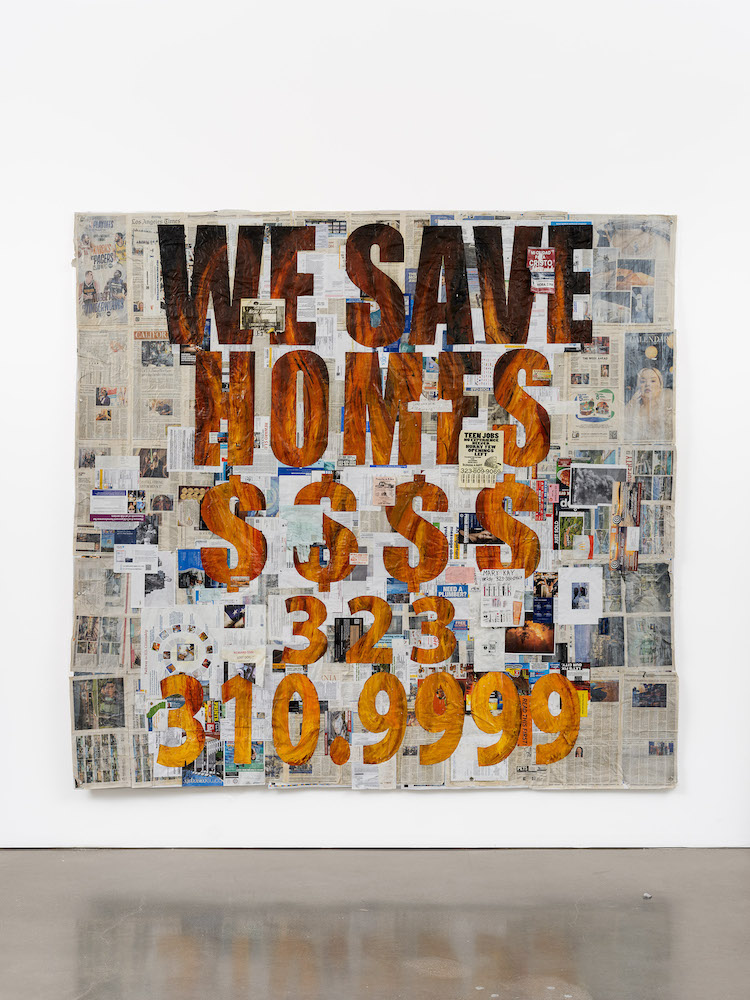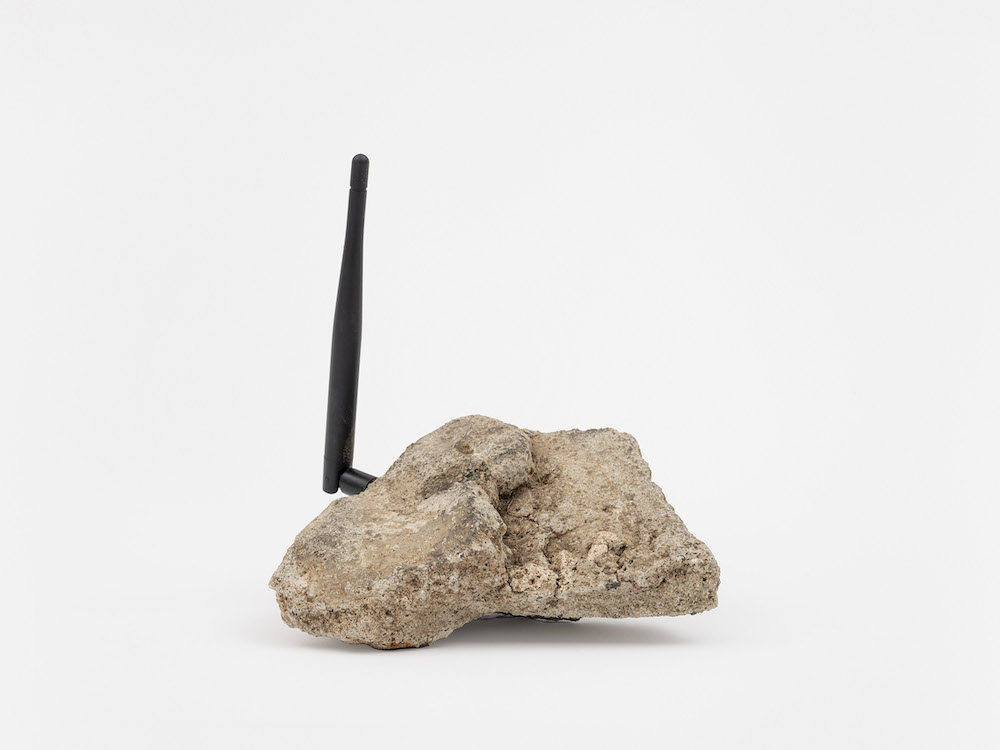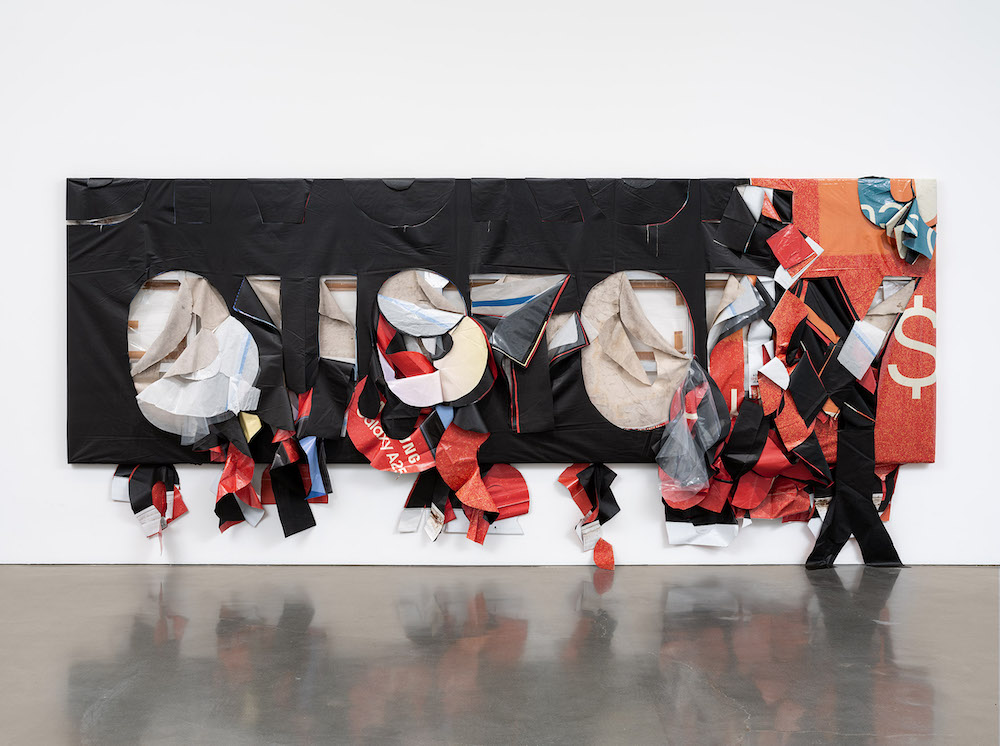Walead Beshty brings five distinct bodies of work together in his exhibition “Profit and Loss” at Regen Projects. In each of these projects, Beshty recasts familiar urban materials (vinyl, newspaper, cement) to expose the undercurrent of suffering and desperation in Los Angeles—a city within a city, hiding in plain sight. Beshty’s work reminds us that staying sane in LA is a daily effort. It is a decision to step over bodies as we move through the city, pretending not to see the tents and RVs lining the sidewalks. We try not to let empathy for the man passed out in the middle of the street, minus his pants, mess up our plans for the day. We try to ignore the people bent in half in a Fentanyl nod. Beshty’s work challenges this obliviousness and suggests that when we look away from the suffering of those at the margins, we also lose the ability to perceive the city in which we live.
The “Bandit Sign Painting” series—five large-scale and eight smaller paintings of common advertisements painted on top of newsprint—reference advertisements that people don’t notice unless they are looking for them out of desperation. These are communications for the disenfranchised—the poor, the undocumented, the unbanked, and the unhoused. Bandit Sign Painting [WE SAVE HOMES $$$$ 323 310.9999 (Los Angeles Times, Sunday 12 May 2024; Los Angeles, California)] (2024), scales up a message that might be invisible except to those who find realtors, attorneys, housing, or employment from a hastily stenciled sign on a wall or fence.

Walead Beshty, Bandit Sign Painting [WE SAVE HOMES $$$$ 323 310.9999 (Los Angeles Times, Sunday 12 May 2024; Los Angeles, California)], 2024. © Walead Beshty. Courtesy of Regen Projects.
What Goes Around Comes Around [TEST STRIPS $CASH$ 424-443-1402] (2024), a reimagined billboard made from layers of peeling vinyl advertisements, plays with proximity. Bringing the scale of the billboard down to eye level makes it difficult to ignore what dilapidation looks like up close. The artist also layers flyers over the vinyl, creating a collage resembling a wall of ads. The viewer can read at close range the wear-and-tear that is inevitable for outdoor advertisements as well as the ephemeral nature of these communications that are repeatedly covered with new ones.
Interpolated with the vinyl series and the newsprint signage series are framed paintings of cigarette butts on newsprint, inspired by Italy’s migrant crisis and the subsequent smuggling of cigarettes through the Port of Tripoli. Some of these Philip Guston-esque works reference Los Angeles through the titles, which name the newspaper surfaces of the drawings. In Los Angeles Times, Wednesday 17 February 2021; Los Angeles, California (2024), cigarette butts suggesting flaccid penises or bodies slump over in defeat.
With 3300 Block to 4400 Block, Union Pacific Avenue, between South Grande Vista Avenue and South Marianna Avenue, Los Angeles/Commerce, California, December 2020 (2021), Beshty urges us to see the working poor who cannot afford housing. The work is a part of a series of black and white photographs Beshty made by reconstructing, across the street from his Boyle Heights studio, a familiar Los Angeles scene: a line of RVs repurposed for makeshift housing. The photographs line a hallway in the gallery near a window that happens to look out on the street where sometimes a similar scene takes place.

Walead Beshty, Smart Object (Router), 2024. © Walead Beshty. Courtesy of Regen Projects.
Cell Device (Pager) (2024), a series of found blocks of cement and bricks sporting black electronic antennas made me think of the exploding pagers in Lebanon. Though the work may have been made before the 2024 IDF attacks on Hezbollah, I interpreted the pager clip and the stone fragment as a compression of time, representing both the intact explosive and the aftermath. The building materials originate from the renovations of the affluent. In contrast to the people who do not have a structure in which to live, there is another socioeconomic class that loves to destroy and rebuild. For “The Blind Collage” series of banknotes, Beshty pieced together cut-up US currency and rearranged it in geometric patterns. The seams are repaired with gold, emulating the Japanese Kintsugi practice of repairing ceramics. It seems as if the privilege of rebuilding and repair only belongs to the affluent.
“Profit and Loss” lays bare the dystopian Los Angeles that exists parallel to the idealized mythology of Hollywood and the broken American Dream.


